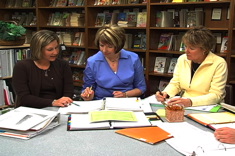The end of the school year is such a precious and busy time. This year we asked Choice Literacy contributors to share some of their favorite ideas and activities for closing out the school year. This article is the second in a two-part series.
Katie Doherty, 6th grade teacher featured on Readers in the Middle DVD:
The end of the year is always a little hectic, and sometimes those last few days with kids can seem almost futile. It’s hard for kids to see the necessity of learning new things; they are glassy-eyed and dazed — dreaming of summer and sleeping in. One of my very last activities of the school year is what I like to call a Genre Recap. We take a few minutes to review some of our favorite genres and what these categories mean.
Then, I challenge my students to grab a friend and book basket (all organized by genre) and inspect each basket to make sure all the books included fit the genre label. When a group is finished, I do a quick check to make sure I agree. The group can then move onto a new genre and new basket. If a book does not belong, the pair can discuss what genre it is, and they can find a more suitable home for the rogue book. This process does a few things for my students and me:
- Students take time to look at and talk about books and perhaps notice a few titles they may want to read over the summer (they add these to their personal book lists).
- The students get a review of types of books, and what each genre entails.
- My book baskets get reorganized for the next school year so that I don’t have to do it all by myself!
I ask each group to share one of the genre baskets they organized. They are expected to present some of the characteristics of that genre, as well as one book from the basket that seemed intriguing to them.
Gail Boushey and Joan Moser, Authors of The Daily Five and The CAFE Book
:
End of the year celebrations are fun, but can be a huge amount of work. A quick and easy end of the year wrap-up that is successful for all ages is to hold an open-ended ‘Learning of the Year’ celebration. The class brainstorms all the different types of things they may want to showcase to each other, other classes of students, or even parents. The list might include: writing samples or journals, published writing, favorite books read from the year, a favorite piece of artwork, a drawing or writing about greatest happenings at lunch, recess, or work with specialists (art, music, physical education).
Students pull together their items to share, either setting up a space in the room simultaneously with the rest of the class, or assigning a few students to present each day. We share these presentations within our own class, with other classes, or have even invited parents in to listen. By leaving that activity open and driven by each child, the sharing is spontaneous and delightful.
Mandy Robek, Author of the Enjoy and Embrace Learning Blog:
When I think about closing out the school year for myself, the most important thing I’ve done every year is carefully pack up my room. I purge and pitch many items. I recycle old supplies to an organization in need that helps support children in an after-school program and during the summer in the city of Columbus, Ohio.
I wash math manipulatives and let them dry in the sunshine. I reorganize the classroom library. Our custodial staff is fantastic in following a room map for setting up my room after their cleaning. I’m not an ever-changing environment creator. Once I find a plan that works I stick with it, year after year and all year long. I clean out all of my assessment notebooks and planbook. For items I have on shelves that will be moved in and out of the room, I organize like items together on built-in shelves to help me quickly put them out in the fall. By doing all this work before I leave for summer, I find summer set up to be quick and easy, allowing me to focus on teaching and planning a new school year.
Look See, Look at Me! by Leonie Norrington and Dee Huxley will be a mentor text for my students to write a reflective piece about the things they can do now at the end of kindergarten. I’m hoping for a variety of responses from my students — about physical growth, independence, and academic learning during our journey together.





